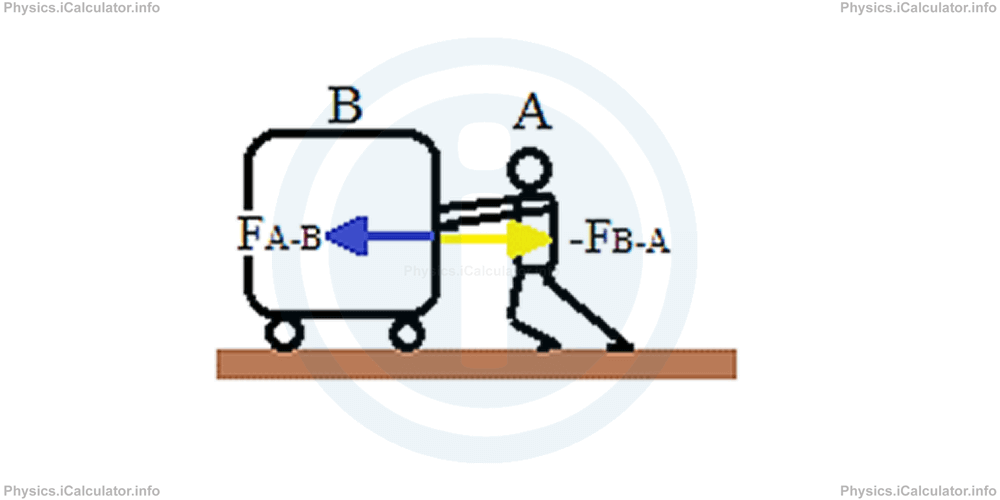Menu
Physics Lesson 4.7.2 - Definition of Newton's Third Law of Motion
Please provide a rating, it takes seconds and helps us to keep this resource free for all to use
Welcome to our Physics lesson on Definition of Newton's Third Law of Motion, this is the second lesson of our suite of physics lessons covering the topic of Newton's Third Law of Motion, you can find links to the other lessons within this tutorial and access additional physics learning resources below this lesson.
Definition of Newton's Third Law of Motion
We can define the Newton's Third Law of Motion in a more comprehensive manner as follows:
"When one body (object) exerts a force on a second body, the second body simultaneously exerts a force equal in magnitude and opposite in direction on the first body."
The Newton's Third Law of Motion is also known as the "Action-Reaction Principle."
Mathematically, we can write:
Look at the figure below:

In the figure above, one man A exerting a force F⃗A-B on the cart B is shown. At the same time, the cart B exerts an equal but opposite force - F⃗B-A on the man. The sign minus of the force exerted by the cart on the man stands for the direction; it represents the opposite direction to the positive force exerted by the man on the cart.
The one million dollar question arisen here is: "Since the action force and the reaction that stems from this action are always equal and opposite, why they are not balanced? Why when we push a box, it moves away but we remain at rest?
The answer is: "Because action and reaction forces do not act on the same object and therefore, they cannot be balanced. Remember from the previous tutorial "Newton's Second Law of Motion" that two forces are balanced when they are equal and opposite and they act at the same object, so that the resultant force is zero. In the action-reaction principle (Newton's Third Law of Motion) it is different; there are two forces acting at two different object (FA-B and FB-A). Therefore, they cannot be balanced as the Newton's Second Law of Motion is applied for each object separately. As a result, the accelerations these forces cause depend on the masses of the objects involved, as the forces are equal. In few words, despite the action and reaction forces are equal in magnitude, they cause different effects in the objects they act (more precisely, in their acceleration) because these objects have different masses.
Let's explain this point through a daily life example. Suppose you went for a trip with your friend for a couple of days. You spent ₤200 per person during the trip. Prior to the trip your savings were ₤1000 and those of your friend only ₤200. Therefore, you still have ₤800 left from your savings but your friend doesn't have any money left. As a result, you enjoyed the trip but your friend regrets his decision to come with you because now he has no more money. Thus, although you both spent the same amount of money, these expenditures caused a different effect in your mood. You are happy and your friend is sad.
Likewise, action and reaction cause different effects in the objects movement. Thus, when the action-reaction principle applies, most probably, one of the objects moves more and the other object moves less or it doesn't move at all.
You have reached the end of Physics lesson 4.7.2 Definition of Newton's Third Law of Motion. There are 4 lessons in this physics tutorial covering Newton's Third Law of Motion, you can access all the lessons from this tutorial below.
More Newton's Third Law of Motion Lessons and Learning Resources
Whats next?
Enjoy the "Definition of Newton's Third Law of Motion" physics lesson? People who liked the "Newton's Third Law of Motion lesson found the following resources useful:
- Definition Feedback. Helps other - Leave a rating for this definition (see below)
- Dynamics Physics tutorial: Newton's Third Law of Motion. Read the Newton's Third Law of Motion physics tutorial and build your physics knowledge of Dynamics
- Dynamics Revision Notes: Newton's Third Law of Motion. Print the notes so you can revise the key points covered in the physics tutorial for Newton's Third Law of Motion
- Dynamics Practice Questions: Newton's Third Law of Motion. Test and improve your knowledge of Newton's Third Law of Motion with example questins and answers
- Check your calculations for Dynamics questions with our excellent Dynamics calculators which contain full equations and calculations clearly displayed line by line. See the Dynamics Calculators by iCalculator™ below.
- Continuing learning dynamics - read our next physics tutorial: What Causes Motion? The Meaning of Force
Help others Learning Physics just like you
Please provide a rating, it takes seconds and helps us to keep this resource free for all to use
We hope you found this Physics lesson "Newton's Third Law of Motion" useful. If you did it would be great if you could spare the time to rate this physics lesson (simply click on the number of stars that match your assessment of this physics learning aide) and/or share on social media, this helps us identify popular tutorials and calculators and expand our free learning resources to support our users around the world have free access to expand their knowledge of physics and other disciplines.